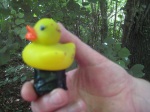Our last full day of our stay in North Devon – and a busy one too!
First stop was the Dartington Glass Factory, where for limited times of day, visitors can see glass being blown, shaped, cooled, checked and boxed in the factory. Unsurprisingly the factory was very, very hot and watching the craftsmen work very mesmerising.
There were no caches close to the factory, so we travelled to the village of Appledore. In former times a bustling fishing port and boat-builders. Our first cache was in sight of boat-building yard, Richmond Dock. A nearby wall proudly shows all the boats made there. Appledore has a strong connection to the Isles of Scilly, which we had visited earlier this year. The ferry link between the Cornwall and Scilly, Scillonian III, was built in Appledore, and Appledore also sends teams to the Gig-Racing World Championships on Scilly.
The cache we were looking for was in some railings, and with no-one (apparently) around, save a lady at a bus-stop, we furiously searched around. We consulted the online logs for a glint of extra information, and with it, Mr Hg137 had the ‘Eureka’ moment of knowing where the cache was. But, at that moment, some tourists arrived (we’ve still no idea how or when they arrived) and stood exactly where Mr Hg137 wanted to search. Eventually they moved off, and we moved in. Cache in hand, log signed…the rest of Appledore Harbour awaited.
Appledore was quiet, very quiet. There were people about, predominantly pensioners, presumably on a day’s excursion. Sitting on seats, drinking tea. We walked by – we were heading for the former railway station (closed in 1917) where a cache was hidden. The station and the former railway line was marked by a wonderful sculpture/mural. We initially thought the cache was attached to it, but a closer inspection of a nearby seat yielded our prize.

Then it all went wrong.
We had got hot at the glass factory, and the day was heating up to…frying our brains. (Leastways that is our excuse). Our last cache was a multi. All we had to do was collect a year from a plaque by the Lifeboat Station and undertake some very simple maths to calculate the coordinates for the final cache. One of the numbers meant multiplying 2 by 2. A child of 5 could do this. We didn’t have a child of 5 with us, just slowly frying brains. For some reason…we made the answer 8 ! (To this day, we don’t know why. We both checked it and the answer was 8).
Off we went, up a very steep hill arriving at a field boundary next to a telegraph pole. The hint, alluded to such a pole, but as we still had some way to go (to our erroneous coordinates), we didn’t check the pole. We stared field-ward. The gate was locked, and no poles anywhere to be seen. After some minutes, we moved back to the car and drove to Westward Ho! still wondering what went wrong.
(Postscript : it was late that evening we re-checked the maths, and realised the pole we had stood next to, was the host! We were within feet of the cache and didn’t look! Oh dear!)

By contrast to the quiet, sleepy nature of Appledore – Westward Ho! was vibrant, noisy and the average age must have dropped by 70 years. Car parks were full (it took us 5 circuits of a car park to get a space, which tested Mr Hg137’s parking ability to the full – remember he can’t multiply 2 x 2 – so how on earth can he park a car?!)
We walked away from the hustle and bustle to collect 3 caches. Two were puzzles we had solved before leaving home (suffice to say three words had been highlighted in each of the cache descriptions which provided a unique method of location identification). The other cache celebrated a famous author. Surprisingly, not Charles Kingsley (author of Westward Ho!), but Rudyard Kipling who attended the United Services College in the Town Centre. (The cache was called Stalky and Co, named after the book written by Kipling based on his experiences at the college).
We strode back to the sea front, and to the North-East of the main beach is a protective bank of pebbles. This protects the sand-dunes of Northam Burrows from the sea. The bank and the pebbles formed the basis of an Earthcache. We took various readings of heights, stone shapes and provided answers as to how the pebbles moved. (Proving we can do geography exams, but we can’t do maths questions!)
Our main target in Westward Ho! was the swimming pool. A tidal swimming pool. With the tide coming in, the pool would be submerged, and unswimmable in less than 2 hours. We returned to the car, and noticed….Mr Hg137 had left his swimming costume in the hotel ! (Can’t do maths, can’t carry a bag out of the hotel…)
Mrs Hg137 changed into her costume (the awkward car parking space provided surprising privacy). Mr Hg137 hatched a plan. His walking trousers were convertible. A knee-high zip would undo the bottom leg portion. So he could swim after all – in slightly too long shorts.
We arrived at the pool – surprisingly cool, and swam, waded and eventually watched the incoming tide splashing against nearby rocks. These splashes became more frequent and we knew our time in the pool was over.
An exhausting day where we learnt about glass-blowing, tested our geography skills but went to the bottom of the class in Maths !
PS We learnt punctuation too…Westward Ho! is the only place in Britain which contains an exclamation mark!
Caches found :































































































































